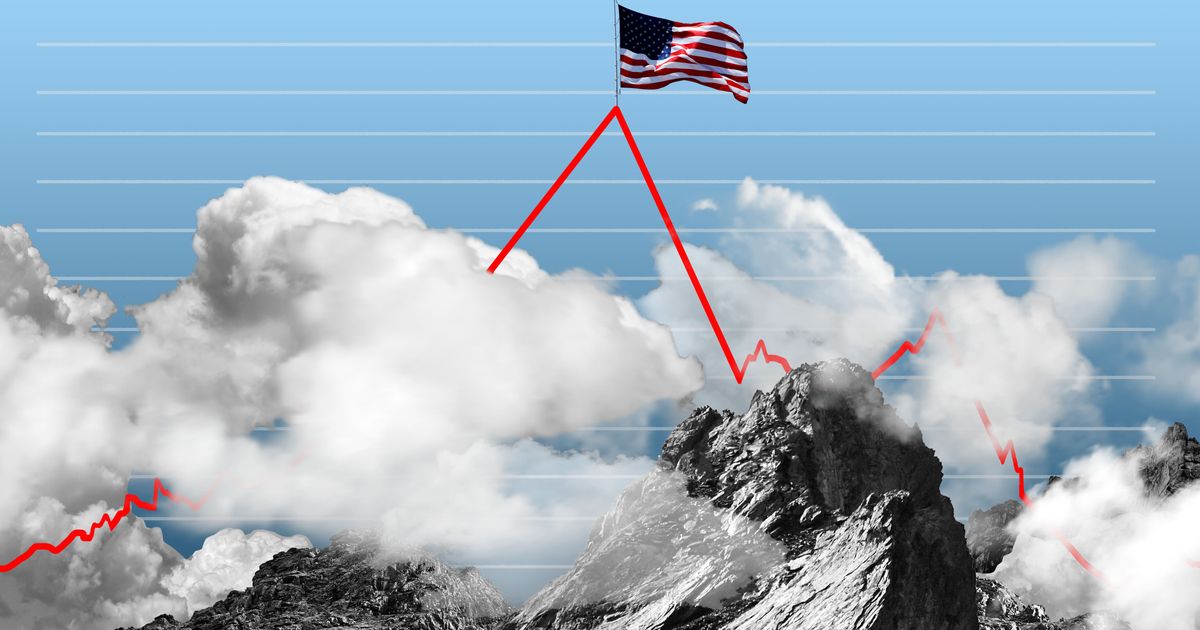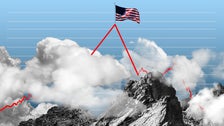
The U.S. Is Still In For A Wild Economic Ride Despite Easing Inflation – Heemang Parmar
[ad_1]

Consumers have been struggling with high inflation over the past year, with the Federal Reserve determined to rein in the economy.
A combination of factors, including Russia’s war in Ukraine, supply chain disruptions as a result of COVID-19, and the strong labor market have all contributed to the inflation picture, Michael Gapen, head of U.S. economics research at Bank of America, told CNBC’s Select in late July.
While inflation is now showing signs of easing, it is still unclear how long this downward trend will continue.
HuffPost spoke to four economy experts to make sense of the challenge facing the Fed and what’s next for the U.S. economy.
What is peak inflation?
Inflation measures how much the price of goods and services has grown over a set period of time, according to the International Monetary Fund.
The Federal Reserve looks at the Consumer Price Index and the labor market to make an assessment on inflation.
Analysts survey households to assess the cost of living for the average family. The CPI tracks the cost of commonly bought items for a household over a base year. In the U.S., mortgages and rents are weighted highly in this index, according to the IMF.
The percentage change in the CPI over a set period of time is one of the most common ways to measure inflation.
In August, the Labor Department announced the CPI increased 8.5% from July 2021 to July 2022, down from 9.1% the previous 12 months.
However, Christelle Khalaf, associate director of the Government Finance Research Center at the University of Illinois Chicago, said the so-called Core CPI, which does not account for food and energy prices, which tend to be volatile, is a more accurate measure of inflation.
Core CPI rose 5.9% yearly and 0.3% monthly in July. The monthly increase is smaller than in April, May or June, according to the U.S. Bureau of Labor Statistics. This monthly 0.3% increase was also less than the projected 0.5%, according to CNBC.
Khalaf said the August metric is also expected to demonstrate inflation is easing.
Investors and analysts are therefore pondering whether the price of goods and services has already reached its highest level — peak inflation — and will continue trending downward.
Has the U.S. hit peak inflation?
Khalaf explained there are still plenty of unknowns about the price trajectory of items making up the Core CPI that helps economists calculate inflation.
“For example, you have the Inflation Reduction Act on one hand, which is expected to lower health care costs, which would subsequently contribute to reducing inflation,” Khalaf said. “On the other hand, the increase in rents is still surging and is expected to keep pushing inflation upwards.”
Rents hit record levels in August, with over half of American cities recording double-digit increases in rent, according to Bloomberg.
Another factor complicating the picture on inflation is the job market. While a strong job market shows the resilience of the U.S. economy, it could also contribute to inflation through wage growth, and is therefore watched closely by the Fed.
The U.S. economy added 528,000 jobs in July, defying economists’ projection for only 250,000 new jobs, according to The Associated Press. In August though, the economy showed signs of cooling off, adding 315,000 jobs, with unemployment rising to 3.5% — a welcome sign for the Fed.
“The labor market is still very strong,” Rhea Thomas, a senior economist at Wilmington Trust, told The Wall Street Journal.
Asked if the U.S. has reached peak inflation, Randall S. Kroszner, who served as a Federal Reserve governor from 2006 to 2009 and is now a deputy dean and economics professor at the University of Chicago Booth School of Business, warned: “Likely, but Mr. Putin’s actions could change that.”
What about gas prices?
Last month, gas prices fell below $4 for the first time in five months due to fears of a recession, according to The Associated Press.
The Energy Information Administration expects that by the fourth quarter of this year, gas prices will fall to $3.78 on average from the current $3.90 average, Energy Secretary Jennifer Granholm told Fox News on Aug. 21.
The White House is hopeful the downward trend will continue but concedes there are still factors outside its control, since oil is traded on the global market.
“If China opens up significantly after COVID, there will be more pressure on demand,” Granholm said. “More pressure on demand means upward pressure on prices.”
Khalaf echoed Kroszner, saying the Ukraine war would also continue affecting energy prices.
“Expectations of a recession might keep oil and gas prices contained, but prices are not expected to decrease much further, especially with the ongoing conflict in Ukraine and its impact on the European markets,” Khalaf told HuffPost.
Wholesale gas prices have been rising as a result of Russian President Vladimir Putin’s war in Ukraine as the continent tries to cut its reliance on the country for natural gas.
That has created upward pressure on prices, though, as countries are left trying to secure gas from alternative sources.
The BBC explains that Europe would typically buy any additional available liquified natural gas from countries including the U.S. and Qatar, but this year countries in Asia have already signed contracts with those suppliers to buy most of that LNG.
This excess demand for gas — with limited supply of gas around the world — has caused prices to skyrocket, contributing to record-high inflation.
Are July’s inflation numbers enough to reassure the Fed?
Despite inflation slightly easing, the current 8.5% rate is still a lot higher than the Fed’s goal of 2%.
In late July — before the Labor Department announced the lower CPI rates — the Fed raised its benchmark interest rate by 0.75 percentage points, effectively increasing the cost of borrowing money, to tame inflation.
Analysts still expect the Fed to continue rising its rates.
“One good print isn’t going to change the Fed’s modus operandi,” Richard Bernstein, CEO of Richard Bernstein Advisors, told Barron’s. “The last thing they want to do is take the foot off the brake and have inflation come ripping back.”
Fed Chair Jerome Powell on Aug. 26 echoed Bernstein, telling the agency’s annual economic symposium in Jackson Hole, Wyoming, that price stability is one of the top priorities for the agency.
While Powell welcomed July’s numbers, he warned a single month’s improvement is not a strong enough indicator that the economy has cooled down.
“Restoring price stability will likely require maintaining a restrictive policy stance for some time,” Powell said. “The historical record cautions strongly against prematurely loosening policy.”
Kroszner agreed with Powell’s approach.
“The Fed needs to continue on its path to tighten monetary policy and bring inflation down,” Kroszner told HuffPost.
But Julianne Malveaux, dean of the College of Ethnic Studies at California State University, Los Angeles, warned interest rate hikes “may not be effective,” describing the inflation situation as “fluid.”
“The Fed cannot control market forces, including supply chain breakdowns, labor market challenges, and other factors,” Malveaux told HuffPost. “They can only make their influence known by increasing interest rates, and this is a mixed tool.”
Powell also recognized that reducing inflation requires slower economic growth, which will inevitably “bring some pain to households and businesses.”
“These are the unfortunate costs of reducing inflation,” Powell said. “But a failure to restore price stability would mean far greater pain.”
Dedrick Asante-Muhammad, the chief of membership, policy and equity at the National Community Reinvestment Coalition, said the Fed should not abandon its full employment mandate in its quest to tame inflation.
“I’m concerned that we’re going to try to combat inflation most disproportionately on the backs of middle-income, low-income people,” which Asante-Muhammad explained is “where unemployment levels matter so much.”
Asante-Muhammad added that the best way to combat inflation is to take money out of higher income brackets.
“I don’t think people being able to pay their rent on time or, you know, buying healthier food are those that are really drivers of inflation,” Asante-Muhammad told HuffPost.
How does inflation affect the prospect of a recession in the U.S.?
Central banks around the world, including the Federal Reserve in the U.S., aim to act as “inflation hawks,” according to the IMF.
While the Fed is planning further interest rate hikes, it will still need to be cautious to avoid sending the economy into a recession.
“I hope that the Fed is not too aggressive in hitting the brakes on the economy, because in my opinion the cost of unemployment at the individual level is much higher and more scarring long term than the burden of slightly higher price growth than the Fed would prefer, especially as wages have remained subdued and are not the main driver of inflation this time around,” Khalaf told HuffPost.
Khalaf explained unemployment can have far-reaching consequences on a person’s health, well-being and lifetime income, but also their family, including their children’s education and employment prospects.
The economy shrank by 0.6% from April to June, according to The Associated Press, the second consecutive quarter that gross domestic product has fallen, which meets the textbook definition of a recession.
In late July, Powell disputed the U.S. was in a recession.
“2.7 million people hired in the first half of the year, it doesn’t make sense that the economy would be in recession,” he said, according to The Wall Street Journal.
Kroszner said it will be the Fed’s interest rate decisions — driven by inflation expectations — that will determine whether the U.S. avoids a recession.
“If inflation comes down steadily and inflation expectations remain well anchored, then the Fed may not have to raise rates so high as to push the economy into recession,” Kroszner told HuffPost.
Asante-Muhammad added that apart from the Fed, it is also important for Congress to act to help the economy recover from the challenges of the past few years, and continue some of the benefits it offered during the pandemic.
Malveaux agreed, calling for enhanced support.
“While many think the government has done enough — or in Republican terms, too much — to alleviate the impact of inflation and the possibility of recession on working people, I am among those who think that we must protect the most vulnerable through federally supported health and child care benefits, legislation that prevents wage theft, and more,” Malveaux said.
[ad_2]






